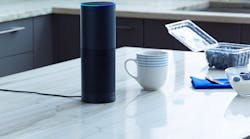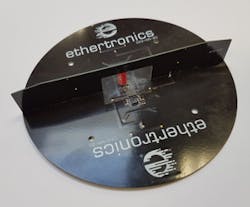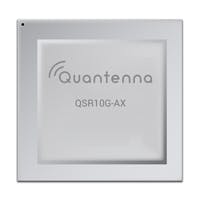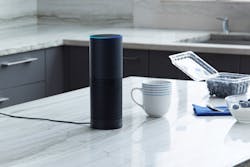This file type includes high resolution graphics and schematics when applicable.
The overall trend affecting wireless communications (along with other sectors of electronics) is the perpetual quest for higher computing speeds and faster data rates. Edholm’s law indicates that bandwidth and data rates have doubled every 18 months over the past three decades. That trend continues. Driving that movement is the greater use of video, the forthcoming VR glut, and the adoption of the new ways that society generates and consumes information and entertainment. Those processes increasingly stress most communications channels. As user capacity also increases, the only natural solution is faster data rates.
With that overall trend in mind, this article outlines progress in some major wireless communications movements, including the Internet of Things (IoT) and the Fifth-Generation (5G) cellular system. Other trends to be covered include progress in the Advanced Driver Assistance Systems (ADAS) automotive program and forthcoming developments with the ubiquitous Wi-Fi.
IoT Coming Into Its Own
IoT has been with us for years, but it is finally beginning to blossom into the network of billions of connected devices predicted by many. Two major growth areas are consumer and industrial. For example, in the consumer space there is an ever-increasing number of wearable products launching. Fitness watches are popular—as are shoe insoles and other devices—for monitoring physical attributes such as pulse and actions like number of steps taken. Medical wearables are also growing in number, making critical monitoring easier.
Home automation is another growing consumer IoT sector. Security and HVAC systems are increasingly made IoT-compatible. Lighting systems using IoT wireless light bulbs are now available, and more and more major appliances are incorporating some wireless connectivity. Wireless door locks and video monitoring systems are becoming more common. Pet and other animal monitoring is a growing application. Wi-Fi and Bluetooth are the dominant wireless technologies used, but others are also involved—for example, 802.15.4 and its ZigBee and Thread derivatives, as well as Z-Wave.
While progress has been made on the consumer IoT front, especially in the home automation sector, the bad news is that consumers are still not buying into the concept (much less know of its existence). Those who are cognizant of IoT believe devices incorporating IoT are just gadgets and gimmicks that may be nice to have, but just aren’t necessary.
Successful devices offer some real benefit and convenience or some addictive behavior. Some such products include thermostats, smartphone video monitors, door locks, and lighting. Many consumers have trouble seeing any real convenience or monetary advantage in products like Wi-Fi refrigerators or other appliances. Some say that the most successful IoT products will be those accompanied by some related service. One example is Netflix, Hulu, and YouTube video over Wi-Fi via a Roku over the top (OTT) video box. Nevertheless, the consumer IoT segment will continue to grow, and the marketplace will begin to sort out what is useful and what is not.
The other IoT growth segment is industrial IoT (IIoT). The good news is that IIoT is seeing most of the action and growth because applications are more easily recognized and benefits more clearly identified. As the incoming U.S. administration pushes for more manufacturing on shore, manufacturing will become more automated, featuring AI-controlled robots and other machines. This movement is what is being called Industry 4.0.
New equipment and systems will deploy hundreds of sensors to collect data about the machines and the processes. Older manufacturing plants will begin to retrofit existing equipment with more sensors and wireless interconnections. In both new and retrofitted facilities, sensors will collect tons of data that will be sent to the cloud for analysis and decision-making—all in order to improve overall productivity, boost reliability, and lower costs. Industrial IoT just makes sense, and that is why it has seen greater adoption than consumer IoT.
Some other key trends to follow are:
The importance of security. This issue continues to hold back the adoption of IoT in all segments. Multiple efforts are underway to develop true secure methods to protect IoT wireless nodes. Otherwise, what we will face is billions of new nodes ripe for hacking.
The emergence of a long-range category. Most current IoT wireless products use short-range technologies like Wi-Fi, Bluetooth, ZigBee, and others. Range extends from a few meters to about 100 meters. A need has been identified for longer-range connections of devices. This need is beginning to be met by chip, module, and system vendors with technologies like LoRa, Sigfox, Nwave, Ingenu, and Weightless.
As part of this movement, cellular IoT (née M2M) is rapidly developing. This is the use of existing LTE cellular systems called LTE-M to carry data for remote monitoring and control operations. For example, the NB-IoT version offers up to 250 kb/s in a 180 kHz OFDM narrowband channel that fits nicely into existing LTE bands. Other LTE-M versions use 1.4, 10 or 20 MHz channels for higher data rates. This is clearly a fast-growing long range sector.
No standards solution. The multiple standards problem, if it is actually a problem, won’t go away. On one hand, multiple standards and product choices are good for developers, as one size does not fit all and the opportunity exists to choose the standard that best fits the application. The downside of this is lack of interoperability between devices and systems. For many applications, however, this is not an issue. In any case, the market will eventually dictate which standards survive.
A lack of qualified personnel. That is business as usual for any new technology. No one has multiple years of IoT experience, yet. Development of IoT is slowed as companies seek people with the right background. Wireless engineers are definitely helpful, but the real need is for programmers and systems designers. IoT is more of a software challenge than a hardware issue.
5G Wireless
The Fifth-Generation cellular system is a work in progress; the Third-Generation Partnership Project (3GPP) is grinding away at the standards details. A final standard is scheduled for the 2019-2020 timeframe, although one carrier (AT&T) is pushing for earlier standard definition in 2017. That may not happen, but it shows the need and interest for faster systems with increased user capacity.
Here is an overview of 5G today:
- Small cells. The 5G system will be a network of small cells mounted on walls, lamp posts, and small masts, as well as indoors. Typical range will be 100 to 200 meters.
- Data rate. The goal is 10 Gb/s under the best conditions. Real data rates will approach 1 Gb/s, but with a common average of 100 to 500 Mb/s.
- Carrier aggregation. Increased bandwidth via combining channels will permit even-higher data rates. This includes the use of unlicensed spectrum such as the 5 GHz ISM/UNII band.
- Latency. Less than 1 ms.
- Modulation. Some variation of OFDM for downstream and a single-carrier variant for uplink.
- Duplexing. TDD.
- Spectrum. Millimeter wave (30 to 300 GHz range) spectrum. 27.5 to 30 GHz, plus 37 and 39 GHz in the U.S.
- Massive multiple-input multiple-output (MIMO). Multi-user MIMO. Antenna arrays from 16 to 1,024 elements.
- Antennas. Active beam steering phased-array antennas for high gain and directivity.
The real key to the success of 5G is the adoption of massive MIMO technology with phased-array beam steering. Beam steering points the antenna in the right direction and focuses the beam to produce boosted transmitter power and higher receiver gain and sensitivity. This increases link reliability and minimizes interference with nearby cells.
There is no clear indication as to how 5G will fit into a smartphone. Apple, Samsung, and the others are just beginning to figure out how to package all that millimeter-wave circuitry with its MU-MIMO and adaptive beamforming phased array, along with the LTE “legacy” hardware.
Because of that challenge and the need for carriers to profit from 5G investments early on, one prediction is that initial 5G service will be fixed wireless broadband. This, of course, is internet connectivity for companies and consumers in competition with existing cable TV, DSL, and fiber broadband providers. That is a promising scenario. Carriers will be busy for years enabling 5G while maintaining and upgrading their 4G LTE networks.
Keep in mind that 4G LTE systems will still remain active for years to come. As it stands, many carriers have yet to upgrade sites to LTE-Advanced Pro (4.5G) that uses carrier aggregation to boost bandwidth and data rate. LTE-Advanced Pro includes key features such as Licensed Assisted Access (LAA) that uses the 5 GHz Wi-Fi band in conjunction with licensed spectrum to provide more bandwidth and higher speeds. Other features are 3D/FD-MIMO (Full Dimension) and latency reduction, among other enhancements. It will boost speed to the 1 Gb/s range keeping LTE vital until full 5G arrives.
Also, because of 5G’s short range in the millimeter spectrum, it will take up to 10 times the number of small cell sites to provide the same coverage as 4G today. That investment will be spread out over a long time. Look for a long life for LTE-A even after 5G shows up.
A question some are asking is how IoT and 5G will intersect, if at all. One possibility is that 5G will provide the capacity to handle the billions of IoT nodes predicted to emerge in the years to come. While high data rates won’t be an issue, the availability of adequate coverage will be. 3GPP added the LTE-M and NB-IoT specifications into the LTE standards, so perhaps we can expect to see some IoT provisions in the 5G specifications.
One clear trend is the advanced work done by the test equipment manufacturers. These companies have really stepped up and contributed to the 5G standards work as well as providing the incredibly complex test instruments and software needed to evaluate and develop 5G products. Congratulations and thanks go to Anritsu, Keysight, National Instruments, Rohde & Schwarz, Tektronix, and others involved in this effort. An example is shown in Fig. 1. This is Anritsu’s MS2840A spectrum/signal analyzer that is the base for 5G testing.
The Connected Car
The adoption of electronic systems in automobiles continues to increase. Vehicles already use dozens if not hundreds of sensors and microcontrollers to monitor and control multiple subsystems. Infotainment, hands-free, and GPS navigation systems are commonplace. Newer vehicles are embracing advanced driver assistance systems (ADAS) that include backup cameras, lane departure detection, adaptive cruise control, and automatic braking. Many vehicles already have built in Wi-Fi hotspots using an LTE cellular link. Now cars are set to become even more connected thanks to programs set forth by the National Highway Transportation Safety Administration (NHTSA).
The new systems enable vehicles to talk to one another (V2V), to nearby infrastructure (V2I), or to other external resources (V2X). Such communications will take place automatically without driver assistance or intervention, although a driver interface will provide notifications and interaction. This communications is expected to be implemented with the Dedicated Short Range Communications (DSRC) system that uses 75 MHz in the 5 GHz band (5.85-5.925 GHz). Vendors are already showing products for DSRC like Ethertronics’ Vehicle to Everything (V2X) antenna (Fig. 2).
The radio technology of DSRC is 802.11p a variant of Wi-Fi. It is similar to 802.11a in that it uses 52 OFDM subcarriers. Instead of the usual 20 MHz channels, 11p specifies seven 10 MHz channels with modulation options that implement data rates from 3 Mb/s to 27 Mb/s. Vehicles will exchange data in the form of a Basic Safety Message (BSM) 10 times per second. The BSM contains information on GPS location, speed, direction, and related conditions. The goal is to have vehicles aware of one another so as to avoid collisions. The NHTSA projects huge decreases in the number of accidents and injuries and an increase in the number of lives saved.
V2I communications involves connections between vehicles and roadside units that will transmit safety and traffic information such as weather, road conditions, traffic light status, nearby accidents and other hazards, parking availability, and tolls. The safety goals of the NHTSA and related benefits will not occur until a critical mass of vehicles are deployed with V2V capability and V2I networks. That will be years in coming. While NHTSA has mandated the incorporation of V2V, it has not announced a requirement date. Automobile manufacturers are beginning to plan for this. As of now, only the 2017 Cadillac CTS has DSRC.
Two issues are apparently slowing adoption. First, the FCC announced that it was considering the use of the DSRC 5 GHz spectrum for expanding Wi-Fi. New Wi-Fi channels would be shared with DSRC spectrum. Many worry that interference between the two services would make DSRC or 802.11ac less reliable. The auto industry prefers 802.11p without Wi-Fi interference. That issue still needs to be resolved.
Second, some say that cellular LTE or cellular 5G (C-5G) should replace DSRC. With new technologies like LTE-M and NB-IoT (and eventually C-5G), vehicles could take advantage of existing communications networks and eliminate the need for a new V2I network. A hybrid system may be possible by using DSRC for V2V and V2I and using cellular connections for V2X. Deliberation continues.
Of course, the self-driving car will be connected with the same technologies. Yet autonomous vehicles are still years away. The delay is no longer a technological problem. The hold-ups are mainly legislative- and insurance-related.
A Word About Wi-Fi
Wi-Fi continues to be not only relevant, but essential to our communications infrastructures. One estimate says that at least 50% of all internet connections occur through Wi-Fi. It has become ubiquitous and addictive. Thankfully, that standard continues to grow and evolve with the times. Devices using the 802.11ac standard have come online quickly, greatly boosting data rates. We can look forward to the 802.11ax standard that is an upgrade over 11ac.
The goal of 11ax is to improve the average throughput per user by a factor of 4 in dense user environments. It achieves this by using OFDMA and multi-user MIMO with beamforming, plus a boost in data rate. The standard supports 8 streams of data in the 5 GHz band and 4 streams in the 2.4 GHz band. It can support a shared data rate up to 7 Gb/s using a 160 MHz channel and 1024QAM. Multiple users can get fast service simultaneously. The 802.11ax is still in draft status, with ratification expected shortly. Already, Quantenna Communications is offering an 11ax chip for access point implementation designated the QSR10G-AX (Fig. 3). Rapid adoption of 11ax is expected.
Also look for increased adoption of the 802.11ad standard called WiGig. It uses the 60 GHz ISM band to achieve data rates of up to 3 Gb/s to a range of 10 meters. Now that the Wi-Fi Alliance has implemented a testing and certification program to ensure interoperability, 11ad should be more widely deployed. Wireless links to replace HDMI, Thunderbolt, and USB-C wired connections are possibilities for video transport. An even faster successor called 11ay is being developed by the IEEE 802 working group.
Wireless Hope
As the relentless push for higher wireless data rates increases and as spectrum space becomes more limited, new technologies are thankfully offering hope for the future. One obvious path forward is to continue to move more products and services into the higher frequencies where the bandwidth exists to support the higher data rates. This is an ongoing process, and we are witnessing it right now as the cellular service is pushing into the millimeter (mm) wave region (30-300 GHz).
Within the coming years the mm-wave bands will fill up, and then what? Relax: There is still some room above the mm-wave bands to be tapped. Specifically, there is the region from 300 GHz to infrared (IR) known as the Terahertz (THz) portion of the spectrum. (A THz is 1000 GHz, or 1012 Hz.) The upper limit of the THz region is sometimes called far infrared (FIR), that segment where radio waves morph into light waves.
This fertile wireless space is essentially untapped, mainly because there are few devices capable of operating at these exalted frequencies. But that is changing. Research and development in semiconductors is now making transistors and integrated circuits for THz use. HEMT and HBT transistors made from InP can produce gain and switching to well above 200 GHz. Even SiGe, GaAs, and Si CMOS have been demonstrated to work at frequencies to 850 GHz.
The downside of THz waves is that, like light, they do not penetrate obstacles. And there is considerable oxygen absorption of the waves, making attention high for long-range operation. There are nevertheless workarounds, and new applications will be discovered as the technology becomes available. While millimeter-wave band technologies will probably peak out at a data rate of 10 Gb/s, look for 100 Gb/s rates and potentially 1 Tb/s with the THz technologies. There is hope in our lifetime.
Voice Communications Becoming More Common
Humans communicate by voice. Now voice-to-devices communications is becoming a popular technology. For example, I have used the Dragon (Nuance) voice-to-text translation software in my writing for years; in fact, I’ve dictated several books with it. While error-prone in its early years, Dragon has improved dramatically over the years thanks to major improvement in artificial intelligence voice recognition software and hardware. And those improvements are now being incorporated into more and more products.
Voice technology is now common in many cars to facilitate more hands-free operation of phone and entertainment devices. And what smartphone does not have AI voice technology? To wit: Apple’s iPhones has Siri, Samsung’s Galaxy has S Voice, and Google’s Pixel has Google Assistant.
Now we have a whole new class of voice-activated devices, including home automation and control systems like Amazon’s Echo and Google’s Home. Known as voice assistants, both serve as Bluetooth speakers and answer questions like Siri. They can also provide control of home IoT devices such as lighting, security, and thermostats. These two devices work by way of the companies’ music subscription, plus Spotify and Pandora. And you can even order products from Amazon using Echo.
More home assistants are on the way. To help with that, Qorvo’s new GP712 radio chip supports multiple communications protocols suited to connected home applications. This chip should bring ZigBee and Thread IoT devices for more voice-activated personal home assistants. Voice-activation used to be iffy. But today, thanks to AI and readily available wireless, it has become far more accurate and reliable. A definite growth trend.
This file type includes high resolution graphics and schematics when applicable.







